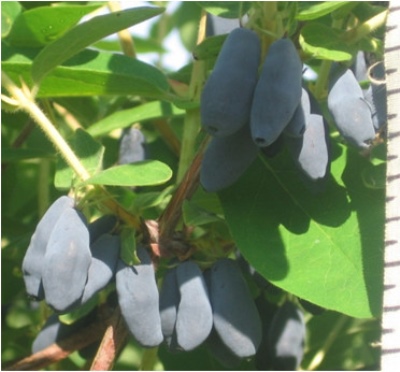
- Authors: N.V. Savinkova, A.V. Gagarkin (Bakcharsky stronghold of the Northern gardening)
- Appeared when crossing: from free pollination 1-45-53
- Year of approval: 2019
- Growth type: vigorous
- Description of the bush: medium spreading, standard
- Bush height, m: 1,9
- Escapes: medium, straight, green, matte, heavily pubescent
- Leaves: ovate, medium, light green, heavily pubescent, matte, leathery, smooth, edges curved upwards
- Crown: reverse conical, oval
- Flowers: medium, pale greenish yellow
Honeysuckle is chosen because of its high decorative qualities, expressive taste and benefits of berries. Despite the existence of a huge variety of this fruit crop, breeders continue to create new varieties. Experts are trying to bring out the most productive and unpretentious variety that will not be afraid of an unfavorable and changeable climate. Among the new varieties, the Ussulga variety stands out, which is recommended for cultivation in Western Siberia.
Description of the variety
The shrubs reach 1.9 meters in height, and the type of growth is marked as vigorous. The spreading of the standard bush is average. As it develops, an oval, reverse-conical crown is formed. Branches are straight and covered with brown-brown bark. Shoots also grow straight, but unlike branches, they are green with a matte surface and pubescent.
The leaves are shaped like an egg. The color is light green, the size is medium. The texture is smooth and matte. The corners are bent upwards. During the flowering period, the branches are covered with medium-sized flowers of a pale green color with a yellow tint.
Due to their large growth, shrubs can be used as a hedge or decoration.
Fruit characteristics
Elongated and oval fruits gain in weight from 1.3 to 2.2 grams. The surface is covered with small bumps. The sizes are large. The color of ripe berries is intense, dark purple. The surface is covered with a thin and smooth skin, without fluff. A thick waxy coating is noticeable. The fruits practically do not crumble, therefore, after ripening, they can remain on the bush for a long time.
Taste qualities
Excellent gastronomic qualities were noted not only by gardeners, but also by professional tasters, who assigned the maximum 5 points to the variety. The taste harmoniously combines sweetness and refreshing sourness. The percentage of sugars - 7.8%, acids - 3.2%.
Ripening and fruiting
The Ussulga honeysuckle variety is medium early, and the exact ripening time depends on the care and weather conditions. Shrubs bear fruit regularly and every year.
Yield
It is not difficult to achieve high yields, since this feature is inherent in the characteristics of this variety. On average, 2.8 kilograms of fruits or 25.9 centners per hectare are harvested from one plant. The maximum yield reaches 4.5 kilograms per shrub. Thanks to its versatility, many healthy desserts can be prepared from honeysuckle.

Self-fertility and the need for pollinators
Due to the fact that the Ussulga variety is self-fertile, it needs the help of pollinators to form fruit. To do this, several varieties of berries are grown at once on the same land plot.
For a successful choice of a pollinator, you need to carefully study the features of each fruit crop. It is advisable to opt for varieties with high yields. It is also recommended to choose varieties that are capable of bearing fruit regularly in a specific climatic zone.Another prerequisite for joint planting is the coincidence of flowering dates.
Growing and caring
When choosing a site for growing Ussulga's garden honeysuckle, you should choose a carefully lit swampy place or lowland. Such an area will be reliably protected from drafts and cold winds. The culture prefers loamy or sandy loam soil. If the soil is depleted, and its composition does not allow growing a rich harvest, it is fertilized with nutrients. Be sure to pay attention to the acidity level. With a high rate, dolomite flour or chalk is added to the site.
When buying seedlings, you should choose plants with a healthy and developed root system. Any defects, like dried roots, should be absent. The general condition of the seedlings is assessed before planting. If necessary, remove broken shoots and shorten roots that are too long.
The planting pit is prepared in advance. The optimal dimensions are 40x40 centimeters. Leave a gap of at least one and a half meters between the plants. The upper layers of the soil, dug out during the preparatory work, are mixed with the following components: wood ash - 300 grams, humus - 1 bucket, potassium sulfate - 30 grams, double superphosphate - 100 grams.
All components are thoroughly mixed and laid out on the bottom of the planting hole. A neat and low mound is formed from the mixture, on top of which a young shrub is installed. In the process of planting, the roots are carefully straightened and after that the pit is completely covered with earth. The root collar of the seedling should be lowered into the ground by no more than 3-5 centimeters.
Watering is carried out taking into account the weather. Honeysuckle loves moderate watering, but in the heat, the earth is moistened more often and in more abundant portions. Honeysuckle is fertilized every 2 years after harvest. To restore strength, you need to feed the culture with a mixture of manure and water in a ratio of 1 to 4.
And also for fertilizing one square meter of the site, a composition of double superphosphate (2 tablespoons), ash (0.1 kilograms) and compost (5 kilograms) is suitable. Top dressing is introduced at the end of autumn.



































































